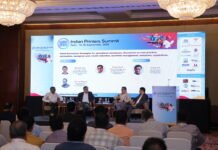
Building public trust in journalism – that was broadly the key theme of the e4m English Journalism Conference held on 13 August 2024 at the India International Center (IIC) in New Delhi.

In his inaugural keynote, Annurag Batra, chairman and editor-in-chief, BW Businessworld and exchange4media (e4m), said today’s journalists need to have a sense of mission, purpose, and idealism. When journalists ask the right questions, they will receive the right answers and the right solutions will follow. According to him, journalists should focus on three issues – quality of life, sustainability, and developmental issues and jobs.
Anant Nath, president – Editor’s Guild of India and editor – The Caravan, delivered a keynote address on challenges from new media laws and reclaiming press freedom in India. Nath said journalism in India is fighting a strong battle of fundamentalism, idealism and religious divide. Media organizations, should, thus, begin reporting with a strong foundational view and let the facts take over.
Several laws have been put together to control media in our country, he said, adding the draft of the Broadcasting Services (Regulation) Bill, 2024 was introduced covertly by the government early this month without public consultations. The ministry of information and broadcasting (MIB) withdrew the latest draft of the bill on Monday, 12 August 2024.

The draft aimed to monitor print, TV and online content in a vague subjective manner with the ultimate power to decide what is right and wrong being given to a government officer. Moreover, the bill extended to social media content creators on YouTube, Instagram and Twitter to control independent voices operating outside of the domain of traditional broadcasting, he said, adding that independent voices have been at the forefront of asking questions in today’s media landscape.
Nath spoke on the Cable and Satellite Television Laws as well as the Indian Press Act by the Imperial government to have elaborate control over the Indian media during British rule, including Gandhi’s Young India and Tilak’s Kesari.

Rajiv Dubey, head of Media, Dabur India, talked about the future of traditional media in India’s advertising ecosystem. TV and print media of Indian regional languages is growing very fast, he said, adding premium product brands such as jewelry, real estate, and automobile companies prefer to advertise in print media due to its trust and credibility. The quality of outdoor signage media has improved significantly in the last few decades, he said, adding the usage of digital media has been on the rise in the last few years owing to the decline in print circulation during the Covid-19 pandemic.
Scale is very important in advertising, he emphasized, adding advertising on a sub-scale level doesn’t yield good results. Brands should come up with advertising strategies based on their product’s USPs, consumer requirements and geography that they are looking to penetrate, he said.

Idris Loya, CEO, Zee Digital, talked about the limitations of TV (broadcast media) as compared to digital. TV has perishability as the progress disappears after some time – it has only 24 hours to sell and is area or geography-specific while digital content is global. TV is considered to be deaf and blind as the viewers are not able to express their opinions. Moreover, there are no options for likability and shareability whereas digital offers avenues for consumer engagement. Also, unlike digital, TV doesn’t offer connectivity and mobility, he said, adding digital also has some disadvantages such as a lack of consumer trust and reach being restricted in certain geographical areas. Due to these issues, shorter, on-demand content is more suited to digital media while TV works in a long and linear format.
Vikram Chandra, founder, Editorji Technologies, spoke on navigating AI in newsrooms and addressing the credibility challenges of automated reporting. AI can do a good job in creating shorter pieces of content such as determining the winner of a hockey match or the current state of the stock market, he said, adding AI can handle these tasks with speed and precision while avoiding spelling and grammatical errors.
However, for complex narratives and opinion-based pieces, human judgment remains essential. AI can help with research but the final analysis and storytelling needs to be done by a human, he said. According to him, though AI can effectively process information, human beings are better equipped to understand biases, context, and nuances of storytelling.
The conference ended with the awards distribution ceremony for e4m English Journalism 40 under 40, which recognized English journalism professionals across print, television and digital platforms. Most of the awarded 29 journalists, anchors, editors, reporters, media professionals, videographers, and news producers were from India Today, NDTV, Hindustan Times and TV9 Network, among others.
The conference was supported by Friends Media PR, PRP Group and Kaizzen along with BW Businessworld.

















